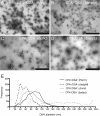Influence of O polysaccharides on biofilm development and outer membrane vesicle biogenesis in Pseudomonas aeruginosa PAO1
- PMID: 24464462
- PMCID: PMC3993350
- DOI: 10.1128/JB.01463-13
Influence of O polysaccharides on biofilm development and outer membrane vesicle biogenesis in Pseudomonas aeruginosa PAO1
Abstract
Pseudomonas aeruginosa is a common opportunistic human pathogen known for its ability to adapt to changes in its environment during the course of infection. These adaptations include changes in the expression of cell surface lipopolysaccharide (LPS), biofilm development, and the production of a protective extracellular exopolysaccharide matrix. Outer membrane vesicles (OMVs) have been identified as an important component of the extracellular matrix of P. aeruginosa biofilms and are thought to contribute to the development and fitness of these bacterial communities. The goal of this study was to examine the relationships between changes in the cell surface expression of LPS O polysaccharides, biofilm development, and OMV biogenesis in P. aeruginosa. We compared wild-type P. aeruginosa PAO1 with three chromosomal knockouts. These knockouts have deletions in the rmd, wbpM, and wbpL genes that produce changes in the expression of common polysaccharide antigen (CPA), O-specific antigen (OSA), or both. Our results demonstrate that changes in O polysaccharide expression do not significantly influence OMV production but do affect the size and protein content of OMVs derived from both CPA(-) and OSA(-) cells; these mutant cells also exhibited different physical properties from wild-type cells. We further examined biofilm growth of the mutants and determined that CPA(-) cells could not develop into robust biofilms and exhibit changes in cell morphology and biofilm matrix production. Together these results demonstrate the importance of O polysaccharide expression on P. aeruginosa OMV composition and highlight the significance of CPA expression in biofilm development.
Figures








Similar articles
-
Pseudomonas Quinolone Signal-Induced Outer Membrane Vesicles Enhance Biofilm Dispersion in Pseudomonas aeruginosa.mSphere. 2020 Nov 25;5(6):e01109-20. doi: 10.1128/mSphere.01109-20. mSphere. 2020. PMID: 33239369 Free PMC article.
-
Tracking the Dynamic Relationship between Cellular Systems and Extracellular Subproteomes in Pseudomonas aeruginosa Biofilms.J Proteome Res. 2015 Nov 6;14(11):4524-37. doi: 10.1021/acs.jproteome.5b00262. Epub 2015 Oct 2. J Proteome Res. 2015. PMID: 26378716
-
Single-Nucleotide Polymorphisms Found in the migA and wbpX Glycosyltransferase Genes Account for the Intrinsic Lipopolysaccharide Defects Exhibited by Pseudomonas aeruginosa PA14.J Bacteriol. 2015 Sep;197(17):2780-91. doi: 10.1128/JB.00337-15. Epub 2015 Jun 15. J Bacteriol. 2015. PMID: 26078447 Free PMC article.
-
Role of polysaccharides in Pseudomonas aeruginosa biofilm development.Curr Opin Microbiol. 2007 Dec;10(6):644-8. doi: 10.1016/j.mib.2007.09.010. Epub 2007 Nov 5. Curr Opin Microbiol. 2007. PMID: 17981495 Free PMC article. Review.
-
Regulation of Biofilm Exopolysaccharide Biosynthesis and Degradation in Pseudomonas aeruginosa.Annu Rev Microbiol. 2022 Sep 8;76:413-433. doi: 10.1146/annurev-micro-041320-111355. Epub 2022 Jun 2. Annu Rev Microbiol. 2022. PMID: 35655342 Review.
Cited by
-
Pseudomonas aeruginosa: An Audacious Pathogen with an Adaptable Arsenal of Virulence Factors.Int J Mol Sci. 2021 Mar 18;22(6):3128. doi: 10.3390/ijms22063128. Int J Mol Sci. 2021. PMID: 33803907 Free PMC article. Review.
-
Relationship Between Membrane Vesicles, Extracellular ATP and Biofilm Formation in Antarctic Gram-Negative Bacteria.Microb Ecol. 2021 Apr;81(3):645-656. doi: 10.1007/s00248-020-01614-6. Epub 2020 Oct 6. Microb Ecol. 2021. PMID: 33025062 Free PMC article.
-
Bacterial membrane vesicles: orchestrators of interkingdom interactions in microbial communities for environmental adaptation and pathogenic dynamics.Front Immunol. 2024 Mar 21;15:1371317. doi: 10.3389/fimmu.2024.1371317. eCollection 2024. Front Immunol. 2024. PMID: 38576623 Free PMC article. Review.
-
Cocaine potentiates an inflammatory response in C6 astroglia-like cells.Biomed Rep. 2021 May;14(5):45. doi: 10.3892/br.2021.1421. Epub 2021 Mar 16. Biomed Rep. 2021. PMID: 33786174 Free PMC article.
-
Outer Membrane Vesicles (OMVs) of Pseudomonas aeruginosa Provide Passive Resistance but Not Sensitization to LPS-Specific Phages.Viruses. 2022 Jan 11;14(1):121. doi: 10.3390/v14010121. Viruses. 2022. PMID: 35062325 Free PMC article.
References
Publication types
MeSH terms
Substances
Grants and funding
LinkOut - more resources
Full Text Sources
Other Literature Sources

